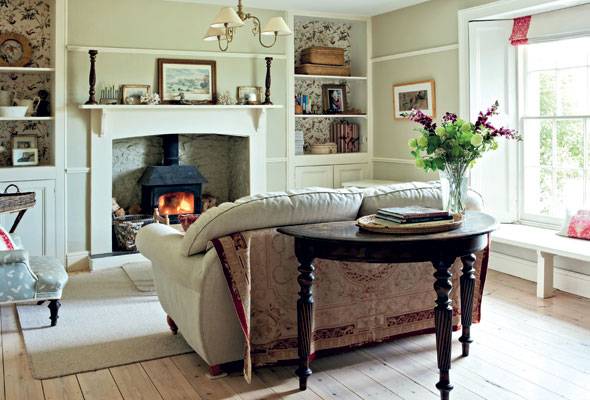Farmhouse chic
 Becca Collison’s large collection of floral crockery makes a fabulous display on a side table and wall shelves in the bakehouse
Becca Collison’s large collection of floral crockery makes a fabulous display on a side table and wall shelves in the bakehouseNobly, Ros Byam Shaw touches on this issue in her introduction to Perfect English Farmhouse. ‘After my initial disappointment that none of the farmhouses were part of traditional working farms,’ she writes, ‘most of these farmhouses are still places of work… But instead of milking, or processing corn, or shearing sheep, the people who live in them are making things, selling things, designing things…’
 The Collisons’ old bakehouse, with brick bread oven, has been annexed to the kitchen. The leather chairs are from an antiques fair and the tablecloth is by Cabbages and Roses
The Collisons’ old bakehouse, with brick bread oven, has been annexed to the kitchen. The leather chairs are from an antiques fair and the tablecloth is by Cabbages and RosesSo, that’s what you get here. Gorgeous houses in the farmhouse style, lived in by people who have probably never seen a cow at close quarters, let alone milked one at 4am on a frosty morning, but who are adept at making their houses look like the real thing. And they do, in a dreaming spires kind of way… low beams, flagstones, wood panelling, comfortable sofas and vast stone fireplaces; rag rugs, Agas and dressers stuffed with ancient crockery.
 A wide arch separates bedroom and bathroom. The roll-top bath has been positioned to maximise the view
A wide arch separates bedroom and bathroom. The roll-top bath has been positioned to maximise the viewThe Richardsons’ house, which appears in the book, was the ‘largest and most expensive antique they had ever bought’. They have restored the house and turned a wrecked barn into a farm shop, from which they sell country antiques, including dolls’ houses employed as cupboards and their collection of Regency and early Victorian portrait silhouettes.
 The informal sitting room is where the Keelings gather to watch TV
The informal sitting room is where the Keelings gather to watch TVAnother of these reutilised farmhouses belongs to the Keelings. It’s an imposing 19th-century house set between Dartmoor and the south coast of Devon. The Keelings have furnished it from local auctions and antiques shops, and they, too, sell antiques, from a couple of converted barns. Their informal sitting room boasts a wood-burning stove and pieces that can withstand the attention of two small boys.
 Alison Hill hides modern packaging inside sleek metal boxes in her pantry. Right: Becca Collison collects floral paintings and hangs them unframed; this one picks up the pink of the vintage pots
Alison Hill hides modern packaging inside sleek metal boxes in her pantry. Right: Becca Collison collects floral paintings and hangs them unframed; this one picks up the pink of the vintage potsThere is one farmhouse in the book that has retained its original acreage, however – Botelot Farm in Cornwall. It’s been in the Tamblyn family since 1860 and today has 300 acres of grazing. Much of the farmhouse interior is as it was 150 years ago, but the farm, under the Countryside Stewardship Scheme, has become a blueprint for successful land conservation and restoration: wildlife habitats are being created, and artificial fertilisers and sprays have been abandoned. It’s become a haven for wild flowers and rare birds – much as the house has become a haven for the ‘real’ 21st-century farmer.
Perfect English Farmhouse, by Ros Byam Shaw, with photography by Jan Baldwin, is published by Ryland Peters and Small, £30. The book is available to readers of The Lady for the special price of £25, incl p&p. Call Macmillan Direct on 01256- 302699 and quote reference GLR 6LI.



